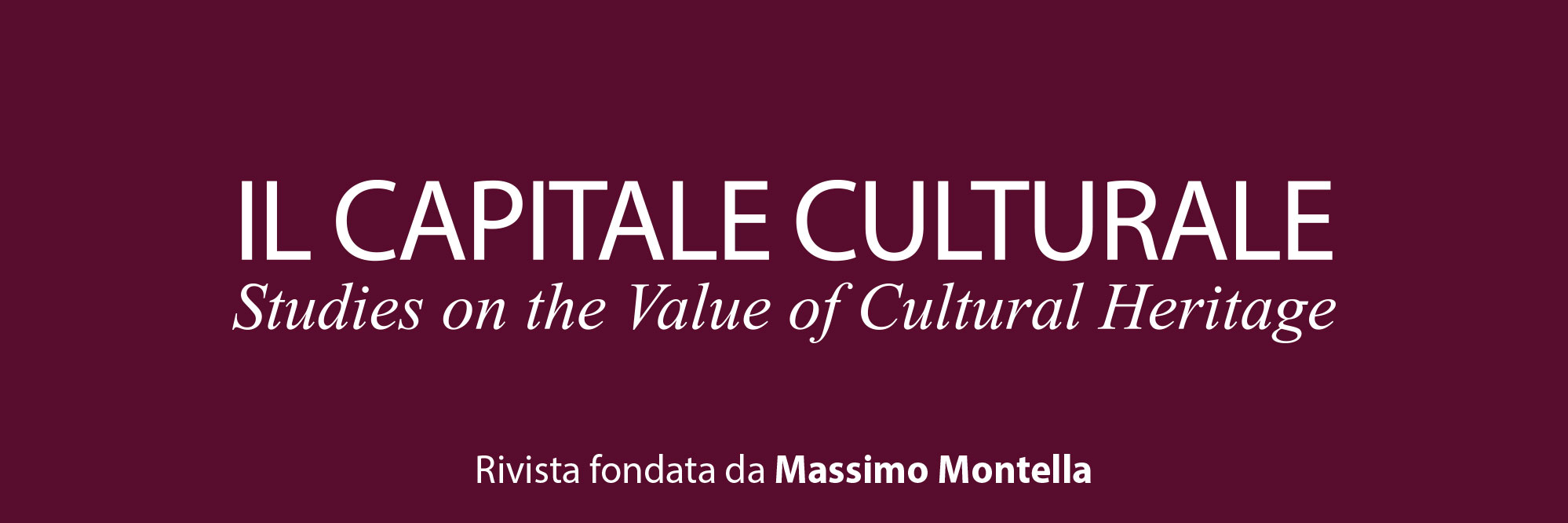Identification and Transgressive Gazing: Paola Gonzaga’s Fontanellato Frescoes
Downloads
Pubblicato
Fascicolo
Sezione
Licenza
Tutti i materiali pubblicati sono coperti da copyright, mantenuto dall'Università di Macerata che ne supporta finanziariamente e tecnicamente la pubblicazione.
La licenza adottata è la Creative Commons - Attribuzione/Condividi allo stesso modo. Ovvero, gli autori che pubblicano su questa rivista accettano le seguenti condizioni:
- Gli autori mantengono i diritti sulla loro opera e cedono alla rivista il diritto di prima pubblicazione dell'opera, contemporaneamente licenziata sotto una Licenza Creative Commons - Attribuzione che permette ad altri di condividere l'opera indicando la paternità intellettuale e la prima pubblicazione su questa rivista.
- Gli autori possono aderire ad altri accordi di licenza non esclusiva per la distribuzione della versione dell'opera pubblicata (es. depositarla in un archivio istituzionale o pubblicarla in una monografia), a patto di indicare che la prima pubblicazione è avvenuta su questa rivista.
- Gli autori possono diffondere la loro opera online (es. in repository istituzionali o nel loro sito web) prima e durante il processo di submission, poiché può portare a scambi produttivi e aumentare le citazioni dell'opera pubblicata.
DOI:
https://doi.org/10.13138/2039-2362/3289Abstract
Of all the early modern depictions of Diana and Actaeon, one of the most unusual is located in a small room inside the Rocca Sanvitale, the castle of Fontanellato in northern Italy. On the ceiling, Parmigianino frescoed scenes featuring the Ovidian tale. While much of the imagery is typical of the period, the most famous scene from the myth, in which the goddess Diana catches Actaeon beholding her nude form, is strikingly less so. This article provides an alternative reading of the ceiling’s iconography, one that considers how the room’s patron, Paola Gonzaga, might have interacted with the frescoes. Through the use of methodologies such as gender and sexuality studies and iconography, I argue here that Parmigianino’s imagery was specifically crafted for a female beholder, Gonzaga, granting her the ability to not only identify with the figures depicted, receiving moral instruction from them, but also sensually enjoy them in private.
Riferimenti bibliografici
Alberti L.B. (1971), The Alberti’s of Florence: Leon Battista Alberti’s Della Famiglia, translated by G.A. Guarino, Lewisburg: Bucknell University Press.
Anderson J. (1996), Rewriting the history of art patronage, «Renaissance Studies», 10, 2, pp. 129-38 .
Arasse D. (1996), Parmigianino au miroir d’Actéon,” in Andromède ou le héros à l’épreuve de la beauté, edited by A. Laframboise, F. Siguret. Paris: Klincksieck, pp. 257-79.
Ariosto L. (1998), Orlando Furioso, translated by G. Waldman, Oxford: Oxford University Press.
Asmus U.D. (1983), Fontanellato I. Sabatizzare il mondo. Parmigianinos Bildnis des conte Galeazzo Sanvitale, «Mitteilungen des Kunsthistorischen Institutes in Florenz», 27, no. 1, pp. 2-40.
Asmus U.D. (1987), Fontanellato II. La trasformazione dell’Amante nell’Amato Parmigianinos Fresken in der Rocca Sanvitale, «Mitteilungen des Kunsthistorischen Institutes in Florenz», 31, pp. 2-58.
Bambach C., et al. (2000), Correggio and Parmigianino: Master Draughtsmen of the Renaissance, London: British Museum Press.
Bandini F., et al. Parmigianino a Fontanellato. Il restauro delle ‘storie di Diana e Atteone, «OPD Restauro», 12, pp. 13-47.
Barkan L. (1980), Diana and Actaeon: The Myth as Synthesis, «English Literary Renaissance» 10, no. 3, pp. 317-59.
Barbaro F. (1677), Directions for Love and Marriage: In Two Books, London: Printed for John Leigh and Tho. Burrell.
Boccaccio G. (2011), Volume 1 of Genealogy of the Pagan Gods, edited and translated by J. Solomon, Cambridge: Harvard University Press.
Bolognesi R. (2018), Correggio e la camera di San Paolo: Svelamenti inediti, Milan: Silvana Editoriale.
Bonsignori da Città di Castello G. (2001), Ovidio Metamorphoseos Vulgare, edited by E. Ardissino, Bologna: I Testi di Lingua.
Brown D.A. (1984), Parmigianino at Fontenellato, «FMR», 1, pp. 140-47.
Brown D.A. (1981), A Print Source for Parmigianino at Fontanellato, in Per A.E. Popham, Parma: Consigli arte, pp. 43-53.
Burke J. (2018), The Italian Renaissance Nude, New Haven: Yale University Press.
Cartari V. (2012), Images of the Gods of the Ancients: The First Italian Mythography, translated by J. Mulryan, Tempe: Arizona Center for Medieval and Renaissance Studies.
Castiglione B. The Book of the Courtier, translated by G. Bull, London: Penguin Books.
Crum R. (2001), Controlling Women or Women Controlled? Suggestions for Gender Roles and Visual Culture in the Italian Renaissance Palace, in Beyond Isabella: Secular Women Patrons of Art in Renaissance Italy, edited by S. Reiss, D. Wilkins, Kirksville: Truman State University Press, pp. 37-50.
Dall’Acqua M., Guadalupi G., Maria Ricci F. (2019), Fontanellato: Rocca Sanvitale, translated by J. Landry, Parma: Franco Maria Ricci.
Dall’Acqua M., Guadalupi G., Maria Ricci F. (1994), Fontanellato, Milan: Franco Maria Ricci.
Ekserdjian D. (2006), Parmigianino, New Haven: Yale University Press.
Fagiolo Dell’Arco, M. (1970), Il Parmigianino: un saggio sull’ermetismo nel Cinquecento, Rome: Mario Bulzoni.
Firenzuola A. (1987), Second Edition of Tales of Firenzuola, New York: Italica Press.
Franklin D. (2003), The Art of Parmigianino, New Haven: Yale University Press.
Freedberg D. (1989), The Power of Images, Chicago: University of Chicago Press.
Freedberg S.J. (1950), Parmigianino: His Works in Painting. Cambridge: Harvard University Press.
Giannetti L. (2010), Ma che potrà succedermi se io donna amo una Donna: Female-Female Desire in Italian Renaissance Comedy, «Renaissance Drama», 36/37, pp. 99-125.
Goffen R. (1997), Sex, Space, and Social History in Titian’s Venus of Urbino, in Titian’s Venus of Urbino, edited by R. Goffen, Cambridge: Cambridge University Press.
Gould C. (1994), Parmigianino, New York: Abbeville Press.
Kelly J. (1984), Women, History, and Theory: The Essays of Joan Kelly, Chicago: University of Chicago Press.
McIver K.A. (1997), Love, Death and Mourning: Paola Gonzaga’s Camerino at Fontanellato, «Artibus et Historiae», 18, no. 36, pp. 101-08.
McIver K.A. (2006), Women, Art and Architecture in Northern Italy, 1520-1580, Burlington: Ashgate.
Melchior-Bonnet S. (1994), The Mirror: A History, translated by K. H. Jewett, New York: Routledge.
Ovid. (2004), Ovid’s Metamorphoses, translated by C. Martin, New York: W.W. Norton & Company.
Ovid. (1954), Ovide Moralisé en Prose (Texte du Quinsième siècle), Amsterdam: North-Holland Publishing Company.
Panofsky E. (1961), The Iconography of Correggio’s Camera di San Paolo, London: The Warburg Institute, University of London.
Periti G. (2016), In the Courts of Religious Ladies: Art, Religion, and Pleasure in Italian Renaissance Convents, New Haven: Yale University Press.
Periti G. (2014/2015), Regarding Parmigianino’s Early Portraits, «Source: Memoirs of the American Academy in Rome», 59/60, pp. 284-309.
Petrarch F. (2001), The Complete Canzoniere: A Translation into English, translated by A.S. Kline, Delaware: On-Demand Publishing LLC.
Popham A.E. (1963), Drawings by Parmigianino for the Rocca of Fontanellato, «Master Drawings», 1, no. 1, pp. 3–10.
Quintavlle A. G. (1968), Gli Affreschi Giovanili del Parmigianino, Parma: Cassa di Risparmio di Parma.
Quintavlle A. G. (2004), Parmigianino, Italy: Rizzoli.
Roskill M.W. (2000), Dolce’s Aretino and Venetian Art Theory of the Cinquecento, Toronto: University of Toronto Press.
Saslow J. (1989), Homosexuality in the Renaissance: Behavior, Identity, and Artistic Expression, in Hidden from History: Reclaiming the Gay and Lesbian Past, edited by M.B. Duberman, M. Vicinus, C. Chauncey, Jr., New York: NAL Books, pp. 90-105.
Sgarbi V. (1983), El baño de Diana, «Art FMR», 14, pp. 192–210.
Simons P. (1994), Lesbian (In)Visibility in Italian Renaissance Culture: Diana and Other Cases of donna con donna, «Journal of Homosexuality», 27, pp. 1-2, 81-122.
Tassi R. (1994), La Corona di Primule: Arte a Parma dal XII al XX secolo, Parma: Ugo Guanda Editore.
Traub V. (1994), The (In)Significance of ‘Lesbian’ Desire in Early Modern England, in Queering the Renaissance, edited by J. Goldberg, Durham: Duke University Press, pp. 62-83.
Vaccaro M. (2002), Parmigianino: The Paintings, Turin: Umberto Allemandi & C.
Vaccaro M. (2004), Reconsidering Parmigianino’s Camerino for Paola Gonzaga at Fontanellato, in Drawing Relationships in Northern Italian Renaissance Art, Burlington: Ashgate, pp. 177-98.
Vecchia V. (1996), Tre donne Sanvitale nel primo Cinquecento a Parma: Susanna, Laura, Paola, «Avrea Parma: rivista quadrimestrale di storia, letteratura e arte» 80, no. 3, pp. 287–95.
Werness H.B. (1999), The Symbolism of Mirrors in Art from Ancient Times to the Present, Lewiston, NY: The Ewin Mellen Press.
Wilkins, D.G. (2001), Introduction: Recognizing New Patrons, Posing New Questions, in Beyond Isabella: Secular Women Patrons of Art in Renaissance Italy, edited by S. Reiss, D. Wilkins, Kirksville: Truman State University Press, pp. 37-50.




